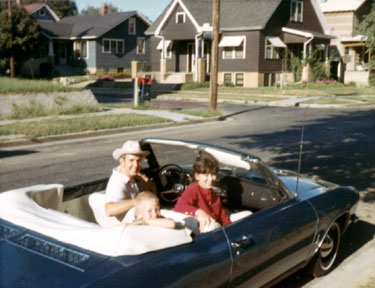I was listening to the Morning Show on WMBD (it used to be the 3-D morning show, but they canned Doc and added Greg, so I don’t know what they call it now… the “G-D Morning Show,” perhaps?), and they were talking about the good old days when people used to be closer to their neighbors, and when relatives and neighbors used to “pop in” unannounced. I didn’t get to hear the whole discussion, but I know that we’ve all gotten a lot more reclusive since we started going from car to attached garage to climate-controlled house. The fact is we just don’t see our neighbors as much anymore to have any interaction with them.
This made me think of a story my great uncle told me. He lived on Pennsylvania Avenue across from White School (the house is long gone and a parking lot for a doctor’s office is there now), and he walked from there to Central (Peoria High) every school day — about a half a mile. Then he would also play tennis with one of his school buddies before school, so he’d get up at 5:30, walk over to Glen Oak Park (about 1.5 miles), play tennis, walk home, clean up, then walk to school. After walking home from school, he would have walked four miles that day.
Can you imagine that happening today? My parents live on Big Hollow Road just a couple houses down from the Glen Hollow shopping center. Their neighbor has a teenage daughter who drove to Michaels one day to buy something. Michaels is practically across the street, about two-tenths of a mile from her house.
What has changed? I think it’s because we’re conditioned in our cities today to rely on our cars. Our cities are planned in such a way that in most cases we have to drive to get anywhere — or take our lives in our hands trying to cross a four- to six-lane, high-speed roadway. My cousin Mike was in the country a few years ago. He lives in Germany and married a German native. Brigitte came with him the last time he visited Peoria and they stayed at a hotel on Brandywine Drive. She was amazed that, even though you could see Northwoods Mall from their hotel, you couldn’t walk there safely or directly. For all practical purposes, you have to drive.
Because of the way residential housing is totally segregated from other types of land use in today’s zoning, it’s not possible for kids to walk to the park to play tennis, then walk to school. They can’t ride their bikes to the mall, either, because to do so they’d have to ride on busy roadways and cross dangerous intersections. Imagine letting your 14-year-old ride his or her bike from, say, Frostwood Parkway to the Shoppes at Grand Prairie. Not hardly. So into the car we go. Cars that increasingly have things like DVD players built in to make our retreat into our own separate worlds yet easier.
So we don’t see our neighbors, and we don’t get exercise. And then, there’s one more thing to make our kids just a little more anti-social: technology in school, especially in elementary education. The Alliance for Childhood put out a report last year called Tech Tonic: Towards a New Literacy of Technology in which they make the claim that “at the elementary school level and below, there is little evidence of lasting gains and much evidence of harm from the hours spent in front of [computer] screens,” and, “research strongly indicates that face-to-face relationships with people and the rest of the natural world are critical not just for young children but for older students as well.” Yet, increased technological training was part of Clinton’s educational plan and is part of Bush’s “No Child Left Behind” plan.
Now, I’m not a Luddite, but do our elementary school kids really need computer training? Does it really aid them in learning? And, perhaps more importantly, does the corresponding decrease in face time and social interaction have a negative effect on their development? “Tech Tonic” concludes just that. They report, “By conservative estimates, schools have spent at least $55 billion in the last 10 years4 on computers and other high-tech products, services, and related training. But there is little solid evidence that these technologies have improved student achievement—let alone that they are cost-effective compared to other interventions.”
I recently talked to a parent of two high schoolers who told me that they do all their research for school reports online — they aren’t even required to go to the library and look up information in books and periodicals. Are books and periodicals really not important anymore? Is all useful information online now and all books can be discarded? It makes me shudder to even type it.
Our lack of interaction with the outside world, from neighbors to nature, is only going to get worse as we become increasingly isolated due to sprawl (car-dependency) and technological devices (self-contained communication and entertainment), and then pass these values on to the next generation through the elementary education system.
Obviously, the answer is not to chuck all modern technology, as that would be impossible and foolish. But we need to recognize that there’s a cause and effect to the way we use technology and the way we design our cities. Instead of blindly accepting what large retail developers tell us, we need to educate ourselves on alternative urban planning designs and evaluate which ones will provide us with the lifestyles we really want for ourselves and our families. We need to measure the effectiveness of technology education in the classroom and take a critical look at the results. If it turns out that it’s not effective, we should be willing to abandon it in favor of more successful teaching methods.

